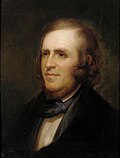Wikipedia:Today's featured article/April 14, 2014: Difference between revisions
Bencherlite (talk | contribs) schedule |
Bencherlite (talk | contribs) tweak |
||
| Line 1: | Line 1: | ||
{{TFAIMAGE|Franklin Peale.jpg}} |
{{TFAIMAGE|Franklin Peale.jpg|Franklin Peale}} |
||
'''[[Franklin Peale]]''' (1795–1870) was an employee and officer of the [[Philadelphia Mint]] from 1833 to 1854. He was the son of painter [[Charles Willson Peale]], and was born in the museum of curiosities that his father ran in Philadelphia. For the most part, Franklin Peale's education was informal, though he took some classes at the [[University of Pennsylvania]]. He became adept in machine making. In 1820, he became an assistant to his father at the museum, and managed it after Charles Peale's death in 1827. In 1833, Peale was hired by the [[United States Mint|Mint of the United States]] ("Mint"), and was sent for two years to Europe to study and report back on coining techniques. He returned with plans for improvement, and designed the first steam-powered coinage press in the United States, installed in 1836. Peale was made Melter and Refiner of the Philadelphia Mint that year, and Chief Coiner three years later upon the retirement of the incumbent, [[Adam Eckfeldt]], who continued in his work without pay. Eckfeldt's labor allowed Peale to run a medal business using Mint property. This sideline eventually caused Peale's downfall: conflicts with Engraver [[James B. Longacre]] and Melter and Refiner [[Richard Sears McCulloh]] led to Peale being accused of misconduct, and he was dismissed by President [[Franklin Pierce]] in 1854. In retirement, Peale continued his involvement in and leadership of many civic organizations; he died in 1870.{{TFAFULL|Franklin Peale}} |
'''[[Franklin Peale]]''' (1795–1870) was an employee and officer of the [[Philadelphia Mint]] from 1833 to 1854. He was the son of painter [[Charles Willson Peale]], and was born in the museum of curiosities that his father ran in Philadelphia. For the most part, Franklin Peale's education was informal, though he took some classes at the [[University of Pennsylvania]]. He became adept in machine making. In 1820, he became an assistant to his father at the museum, and managed it after Charles Peale's death in 1827. In 1833, Peale was hired by the [[United States Mint|Mint of the United States]] ("Mint"), and was sent for two years to Europe to study and report back on coining techniques. He returned with plans for improvement, and designed the first steam-powered coinage press in the United States, installed in 1836. Peale was made Melter and Refiner of the Philadelphia Mint that year, and Chief Coiner three years later upon the retirement of the incumbent, [[Adam Eckfeldt]], who continued in his work without pay. Eckfeldt's labor allowed Peale to run a medal business using Mint property. This sideline eventually caused Peale's downfall: conflicts with Engraver [[James B. Longacre]] and Melter and Refiner [[Richard Sears McCulloh]] led to Peale being accused of misconduct, and he was dismissed by President [[Franklin Pierce]] in 1854. In retirement, Peale continued his involvement in and leadership of many civic organizations; he died in 1870. {{TFAFULL|Franklin Peale}} |
||
Recently featured: [[Pavle Đurišić]] – [[Triangulum]] and [[Triangulum Australe]] [[Frank Berryman]] |
Recently featured: [[Pavle Đurišić]] – [[Triangulum]] and [[Triangulum Australe]] [[Frank Berryman]] |
||
Revision as of 08:47, 7 April 2014
Franklin Peale (1795–1870) was an employee and officer of the Philadelphia Mint from 1833 to 1854. He was the son of painter Charles Willson Peale, and was born in the museum of curiosities that his father ran in Philadelphia. For the most part, Franklin Peale's education was informal, though he took some classes at the University of Pennsylvania. He became adept in machine making. In 1820, he became an assistant to his father at the museum, and managed it after Charles Peale's death in 1827. In 1833, Peale was hired by the Mint of the United States ("Mint"), and was sent for two years to Europe to study and report back on coining techniques. He returned with plans for improvement, and designed the first steam-powered coinage press in the United States, installed in 1836. Peale was made Melter and Refiner of the Philadelphia Mint that year, and Chief Coiner three years later upon the retirement of the incumbent, Adam Eckfeldt, who continued in his work without pay. Eckfeldt's labor allowed Peale to run a medal business using Mint property. This sideline eventually caused Peale's downfall: conflicts with Engraver James B. Longacre and Melter and Refiner Richard Sears McCulloh led to Peale being accused of misconduct, and he was dismissed by President Franklin Pierce in 1854. In retirement, Peale continued his involvement in and leadership of many civic organizations; he died in 1870. (Full article...)
Recently featured: Pavle Đurišić – Triangulum and Triangulum Australe Frank Berryman

